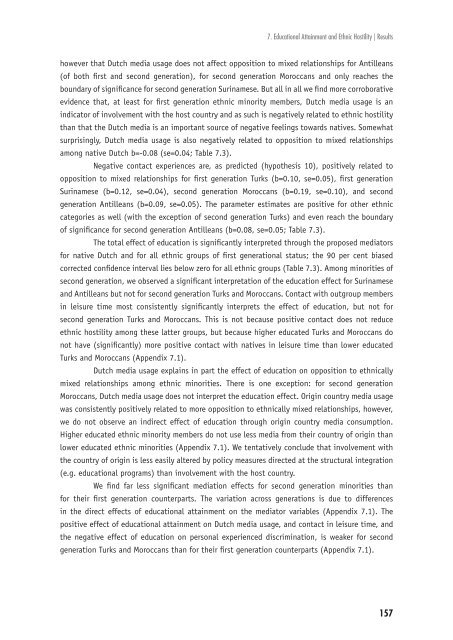Ethnic Hostility among Ethnic Majority and Minority Groups
Ethnic Hostility among Ethnic Majority and Minority Groups
Ethnic Hostility among Ethnic Majority and Minority Groups
Create successful ePaper yourself
Turn your PDF publications into a flip-book with our unique Google optimized e-Paper software.
7. Educational Attainment <strong>and</strong> <strong>Ethnic</strong> <strong>Hostility</strong> | Results<br />
however that Dutch media usage does not affect opposition to mixed relationships for Antilleans<br />
(of both fi rst <strong>and</strong> second generation), for second generation Moroccans <strong>and</strong> only reaches the<br />
boundary of signifi cance for second generation Surinamese. But all in all we fi nd more corroborative<br />
evidence that, at least for fi rst generation ethnic minority members, Dutch media usage is an<br />
indicator of involvement with the host country <strong>and</strong> as such is negatively related to ethnic hostility<br />
than that the Dutch media is an important source of negative feelings towards natives. Somewhat<br />
surprisingly, Dutch media usage is also negatively related to opposition to mixed relationships<br />
<strong>among</strong> native Dutch b=-0.08 (se=0.04; Table 7.3).<br />
Negative contact experiences are, as predicted (hypothesis 10), positively related to<br />
opposition to mixed relationships for fi rst generation Turks (b=0.10, se=0.05), fi rst generation<br />
Surinamese (b=0.12, se=0.04), second generation Moroccans (b=0.19, se=0.10), <strong>and</strong> second<br />
generation Antilleans (b=0.09, se=0.05). The parameter estimates are positive for other ethnic<br />
categories as well (with the exception of second generation Turks) <strong>and</strong> even reach the boundary<br />
of signifi cance for second generation Antilleans (b=0.08, se=0.05; Table 7.3).<br />
The total effect of education is signifi cantly interpreted through the proposed mediators<br />
for native Dutch <strong>and</strong> for all ethnic groups of fi rst generational status; the 90 per cent biased<br />
corrected confi dence interval lies below zero for all ethnic groups (Table 7.3). Among minorities of<br />
second generation, we observed a signifi cant interpretation of the education effect for Surinamese<br />
<strong>and</strong> Antilleans but not for second generation Turks <strong>and</strong> Moroccans. Contact with outgroup members<br />
in leisure time most consistently signifi cantly interprets the effect of education, but not for<br />
second generation Turks <strong>and</strong> Moroccans. This is not because positive contact does not reduce<br />
ethnic hostility <strong>among</strong> these latter groups, but because higher educated Turks <strong>and</strong> Moroccans do<br />
not have (signifi cantly) more positive contact with natives in leisure time than lower educated<br />
Turks <strong>and</strong> Moroccans (Appendix 7.1).<br />
Dutch media usage explains in part the effect of education on opposition to ethnically<br />
mixed relationships <strong>among</strong> ethnic minorities. There is one exception: for second generation<br />
Moroccans, Dutch media usage does not interpret the education effect. Origin country media usage<br />
was consistently positively related to more opposition to ethnically mixed relationships, however,<br />
we do not observe an indirect effect of education through origin country media consumption.<br />
Higher educated ethnic minority members do not use less media from their country of origin than<br />
lower educated ethnic minorities (Appendix 7.1). We tentatively conclude that involvement with<br />
the country of origin is less easily altered by policy measures directed at the structural integration<br />
(e.g. educational programs) than involvement with the host country.<br />
We fi nd far less signifi cant mediation effects for second generation minorities than<br />
for their fi rst generation counterparts. The variation across generations is due to differences<br />
in the direct effects of educational attainment on the mediator variables (Appendix 7.1). The<br />
positive effect of educational attainment on Dutch media usage, <strong>and</strong> contact in leisure time, <strong>and</strong><br />
the negative effect of education on personal experienced discrimination, is weaker for second<br />
generation Turks <strong>and</strong> Moroccans than for their fi rst generation counterparts (Appendix 7.1).<br />
157












